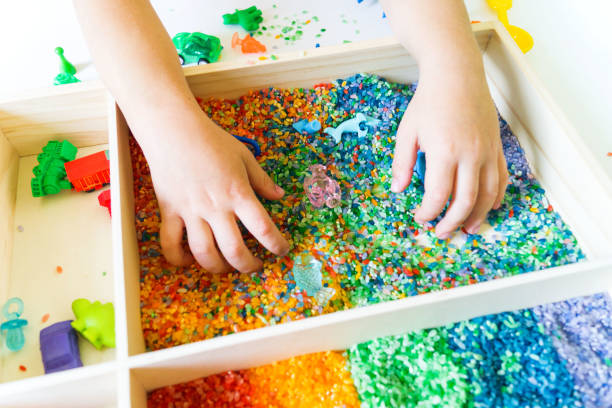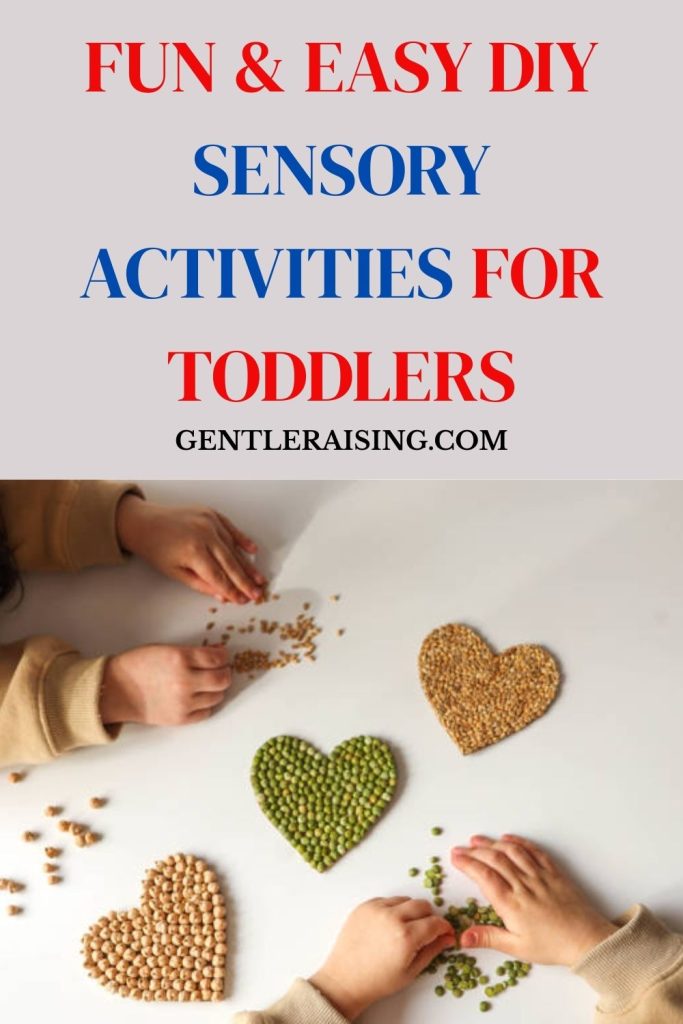When a Cardboard Box Beats the Fancy Toy
Have you ever noticed how toddlers seem to get more excited about the wrapping paper than the actual gift inside? Or how they’ll spend 20 minutes poking at a cardboard box while ignoring the expensive toy you carefully picked out? If you’ve been there, you’re not alone, and honestly, you’re witnessing a little miracle called sensory play.
Sensory play isn’t just about keeping toddlers busy (though that’s a huge win for parents desperate for five minutes of peace). It’s about stimulating their senses, touch, sight, hearing, taste, and smell, in ways that build the brain, calm big emotions, and strengthen little hands and muscles. And the best part? You don’t need a Pinterest-worthy setup or pricey Montessori subscription box. Your kitchen pantry, your backyard, even the recycling bin hold endless possibilities.
This guide will walk you through DIY toddler sensory play ideas, messy, simple, and affordable, that you can actually pull off without losing your sanity. We’ll mix in practical tips, a few real-parent tangents (because life isn’t perfect), and some science-backed reasons why letting your kid smear spaghetti on the table might be better than you think.
Why Sensory Play Isn’t Just “Messy Fun”
Let’s clear this up right away: sensory play isn’t “just play.” It’s brainwork in disguise. When your toddler digs their fingers into rice, splashes water, or squishes playdough, their brain is firing connections at lightning speed. Neural pathways form, muscles strengthen, emotions regulate, all under the cover of “making a mess.”
- Language development: When you name textures (“smooth,” “squishy,” “crunchy”), toddlers connect words with experiences. That’s how vocabulary explodes.
- Problem-solving and creativity: What happens if I pour sand on water? What sound does rice make when I shake it in a jar? Sensory play is like a mini science lab.
- Motor skills: Scooping beans or pinching playdough works those little muscles they’ll need later for writing and tying shoelaces.
And here’s the kicker: sensory play helps toddlers manage emotions. Ever seen a kid calm down while sifting sand through their fingers? That repetitive, tactile action soothes their nervous system. So yes, when your toddler smears yoghurt all over their highchair tray, they’re doing more than making a mess; they’re practising mindfulness in their own toddler way.
Setting the Scene Without Losing Your Sanity
Now, before you imagine flour explosions and glitter permanently embedded in your couch cushions, let’s talk logistics. Sensory play doesn’t have to take over your home. A little prep makes all the difference.
- Containment is your friend: Use a plastic bin, an old baking tray, or even a shower curtain on the floor. Think of it like building a “messy zone” your toddler can rule without wrecking the house.
- Clothing matters: Strip down to a diaper or throw on an oversized T-shirt you don’t mind ruining.
- Keep it short and sweet: Toddlers have short attention spans. Ten minutes of focused sensory play is worth more than forcing thirty minutes.
Pro tip? Keep a dedicated “sensory play kit” handy: a big bin, a couple of scoops/spoons, some measuring cups, and an old towel. That way, when the toddler energy storm hits, you can set things up in under two minutes.
Oh, and let’s not forget the seasons. In summer, half of these activities can happen outside, where you can shrug off spilt rice and sticky water with a hose. In winter? Bring it inside with smaller bins and washable materials. The point is flexibility, not perfection.
Everyday Sensory Ideas from the Kitchen
The kitchen might just be the world’s best toddler playroom. Everything’s accessible, safe-ish with supervision, and usually edible (which matters when you’re dealing with toddlers who put everything in their mouths).
- Oats and Scoops
Pour dry oats into a bin, toss in some measuring cups, and let your toddler go wild. It’s basically toddler gold. Add small containers for pouring practice. You’ll be amazed at how long they’ll stick with it. - Cooked Pasta Play
Spaghetti, penne, and even rice, once cooked and cooled, become sensory magic. Add a few drops of food colouring for rainbow pasta and watch your toddler squish, tear, and “cook.” Pro tip: drizzle with a bit of oil to keep it from sticking together. - Ice Cube Science
Freeze small toys inside ice cubes and let your toddler “rescue” them with warm water, spoons, or salt. It’s part science experiment, part treasure hunt. Plus, it cools them down on a hot day. - Baking Soda and Vinegar Fun
Safe, bubbly, and endlessly fascinating. Give them small bowls of vinegar with droppers or spoons and let them add it to the baking soda. Fizzy magic. (And yes, it cleans as it goes, a bonus.)
Quick digression: In some cultures, food isn’t used for play because it feels wasteful or disrespectful. If that’s you, no problem. Swap food-based activities for safe alternatives like pom-poms, beads, or water beads (though watch those closely with toddlers under three).
Nature is the Best Free Toy Box
Here’s the thing—toddlers are naturally wired to love dirt, leaves, and puddles. And that’s good news for you because nature play is free, endlessly adaptable, and wonderfully messy in the healthiest way.
- Leaf and Pinecone Treasures
Take a nature walk with a small basket. Collect leaves, sticks, rocks, or pinecones. At home, make a “nature bin” where they can sort by size, texture, or colour. Bonus: it’s a stealthy way to teach categorisation. - Mud Kitchens
All you need is a few old pots, spoons, and a patch of dirt. Toddlers will stir, pour, and “bake” mud pies for hours. Yes, it’s dirty. But dirt exposure is linked to stronger immune systems and even improved mental health. - Water Play Outdoors
Buckets, cups, sponges, and a little water. That’s it. Your toddler will invent games you never thought of. Add bubbles if you’re feeling fancy.
Sometimes, the hardest part as a parent is letting go of the “ugh, the mess” reaction. But here’s the perspective shift: the mud will wash off, but the joy and learning stick.
Quiet Play for Rainy Days
Not every sensory play idea has to be loud, wet, or outdoors. Sometimes you need quiet activities that engage the senses while giving you a moment of peace.
- Sensory Bottles
Fill a clear bottle with water, a bit of oil, and glitter or beads. Seal it tight (glue if necessary). Toddlers can shake, roll, and watch the sparkles float down. It’s basically a toddler snow globe. - Fabric Baskets
Collect scraps of fabric, scarves, or old clothes with different textures. Let toddlers explore with their hands, drape scarves over their heads, or play peekaboo. - Cotton Ball Snow Bin
Fill a tray with cotton balls, add spoons or small toys, and let them dig. Add tongs for older toddlers to practice fine motor skills. - Mystery Bag Game
Hide everyday objects a spoon, a block, a toy car) in a bag. Let your toddler reach in and guess by touch before pulling it out. It’s sensory + language + giggles all in one.
DIY Crafty Creations
For parents who enjoy a little kitchen science or crafting, homemade sensory materials are satisfying to make and surprisingly easy.
- Homemade Playdough
Classic recipe: flour, salt, water, oil, and a ream of tartar. Add food colouring or natural dyes (turmeric for yellow, beet powder for pink). Store in an airtight container. - Edible Slime for Younger Toddlers
Mix chia seeds with water and let sit until gooey, or make a cornstarch-and-water mixture (oobleck). Safe if it ends up in the mouth, unlike the glue-based slimes. - DIY Kinetic Sand
Combine flour with a bit of baby oil. It clumps like sandcastle sand, but softer. Perfect for indoor scooping and moulding.
Word of caution: Always check ingredients for allergies (wheat, corn, etc.) and adjust recipes as needed.
When Sensory Play Becomes Learning Play
The line between play and learning is beautifully blurry for toddlers. Sensory activities can sneak in early math, literacy, and science without feeling “academic.”
- Sorting and Counting
Give them beans, buttons, or pom-poms to sort by colour or size. Count together. It’s math disguised as fun. - Salt Tracing Trays
Spread salt or flour in a tray and let toddlers draw shapes, letters, or just scribbles with their fingers. Older toddlers can practice writing letters. - Sound Experiments
Fill containers with different items (rice, coins, pasta). Shake and guess what’s inside. Introduces concepts of volume, pitch, and rhythm.
Think of it like sneaking veggies into spaghetti sauce, you’re giving them learning without the “sit down and study” vibe.
Real-Parent Tips (From Someone Who Gets It)
Here’s the unpolished truth: sensory play is amazing, but it can also be overwhelming. So here are some sanity-saving tips:
- Keep it simple. A bowl of water and a spoon are enough.
- Join in sometimes, but don’t feel guilty if you use it as a breather.
- Repetition is gold. Toddlers thrive on doing the same thing again and again.
- Get siblings involved by assigning “helper” roles. It reduces rivalry and gives older kids purpose.
- Mess happens. The sooner you accept rice under your couch cushions as part of parenthood, the freer you’ll feel.
Safety Notes Without Killing the Fun
Okay, quick PSA: sensory play should be fun, not stressful. But a few common-sense safety checks go a long way.
- Watch for choking hazards: Small items like beads, beans, or coins are a no-go for toddlers under three unless directly supervised.
- Check allergies: Wheat in playdough, dairy in yoghurt play, nuts in sensory bins, always check.
- Never leave unsupervised: Even with “safe” materials, accidents happen fast.
- Easy cleanup hacks: Keep a small handheld vacuum nearby, or use vinegar for slime cleanup. Prevention is easier than scrubbing.
Conclusion: The Messy, Beautiful Reality
Parenting toddlers is messy, literally and emotionally. Sensory play won’t erase the chaos, but it can channel it into something meaningful, joyful, and surprisingly educational.
One day,y you’ll step on dried rice in the corner of your kitchen and, instead of groaning, you might smile, remembering the giggles and wide-eyed wonder. The mess is temporary. The memories and skills last.
So, start small. Pick one of these DIY toddler sensory play ideas this week: oats in a bin, ice cube treasures, or even a mud pie session. Sit nearby, sip your coffee, and watch your toddler discover the world one squish, scoop, and splash at a time.
Because here’s the secret: sensory play isn’t about perfect activities or Insta-worthy setups. It’s about connection. And that, more than anything, is what your child will carry with them long after the rice is swept up.

